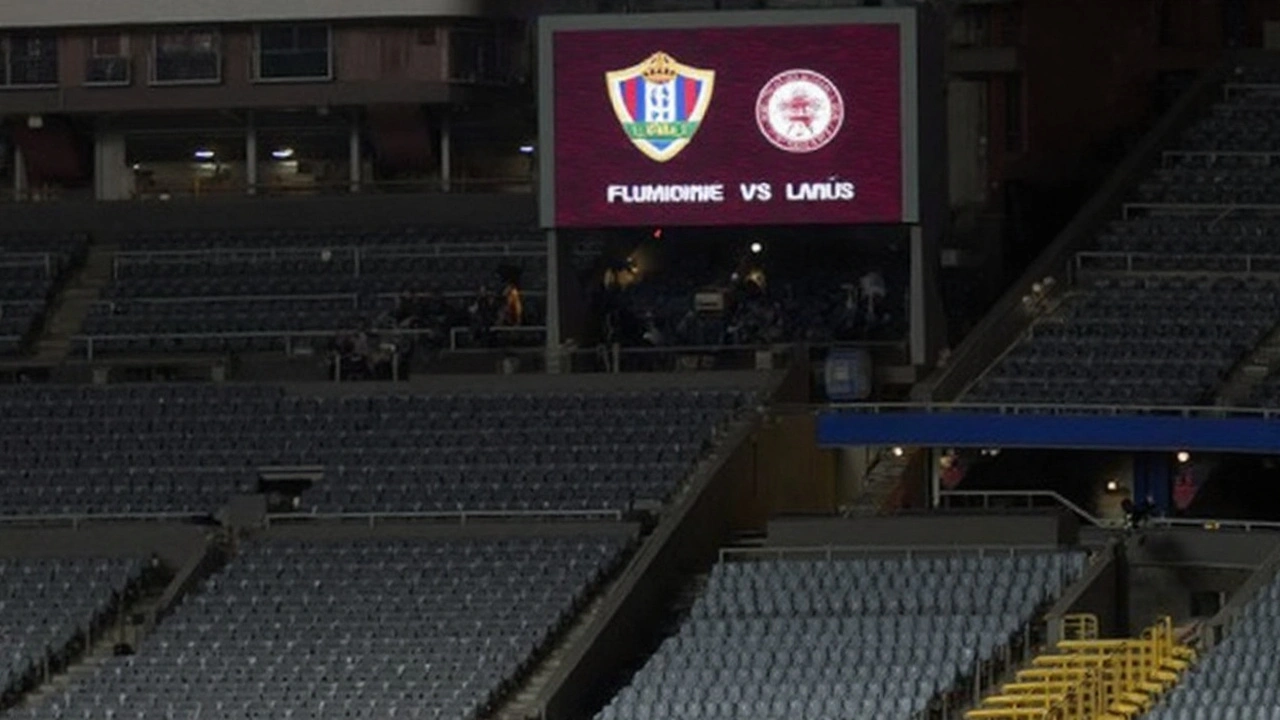Match Overview
When the second leg of the Copa Sudamericana quarterfinal kicked off at Rio’s legendary Estádio do Maracanã on September 23, 2025, the atmosphere was electric. Fluminense, backed by a sea of white and green, knew they had to win by at least two goals to overturn the 1‑0 loss they suffered in Argentina three weeks earlier. The fans were vocal, the lights were blinding, and the stakes could not have been higher.
Early on, the home side seemed to have found the breakthrough they needed. In the 20th minute, Agustín Canobbio slipped past a tired defense and parked the ball in the net, sending the crowd into a frenzy. The goal gave Fluminense a lifeline and forced Lanús into a defensive scramble. For a while, it looked as if the Brazilian giants might rally and force extra time.
But Lanús, under Mauricio Pellegrino, had a game plan that hinged on discipline and a single, decisive counter‑attack. Their midfield, anchored by the composure of seasoned veterans, kept pressuring Fluminense’s backline, waiting for the moment to strike. That moment arrived in the 67th minute when 20‑year‑old Dylan Aquino, a relatively unknown name outside Argentine circles, collected a loose ball outside the box, turned sharply, and fired a low drive into the bottom corner. The goal not only equalised the match but also restored the Argentine side’s aggregate lead to 2‑1, meaning Fluminense now needed two more tallies.
As the clock ticked, Fluminense pushed forward, but Lanús’s defence held firm. A heart‑stopping incident occurred when Germán Cano’s header rattled the crossbar, prompting a collective gasp from the stadium. The missed opportunity epitomised the frustration that would haunt the Brazilian side for the remainder of the night.

Implications and Aftermath
The drama didn’t end at the final whistle. Midway through the second half, a scuffle erupted in the stands between Lanús supporters and local police. The clash forced officials to temporarily suspend play while security cleared the area and restored order. The interruption added a layer of tension that mirrored the on‑field battle and reminded everyone that South American football can be as volatile off the pitch as it is on it.
For Renato Gaúcho, the loss was a bitter pill. His team had displayed flashes of brilliance in the domestic league, most recently a 1‑0 win over Vitória that highlighted their attacking potential. Yet, against a well‑organised Lanús side, Fluminense’s creative spark sputtered. The inability to break down a compact defence, combined with a few missed chances, ultimately sealed their destiny in the tournament.
Lanús, on the other hand, celebrated a historic achievement. Advancing to the semifinals marked one of the club’s deepest runs in a continental competition. Pellegrino’s tactical approach—focus on a solid backline, quick transitions, and exploiting set‑piece opportunities—proved effective against a heavyweight opponent. The young Aquino, now a hero in Buenos Aires, will be looking at interest from bigger clubs, but his loyalty to the squad will be a talking point as they prepare for the next round.
Looking ahead, Lanús will face a new challenger in the semifinal, a matchup that promises another clash of styles and tactics. Their confidence will be high, but the road ahead is still long; any slip could see their dream of South American glory evaporate. Fluminense must regroup quickly, refocus on their Série A campaign, and start planning for next season’s continental aspirations.
In the broader picture, the tie illustrated why the Copa Sudamericana remains one of the most unpredictable tournaments on the continent. A young midfielder’s goal, a fan disturbance, and a nail‑biting finish—all within a single night—remind fans that football in South America is never short on drama. The story of Lanús’s advancement will be replayed across barrooms and living rooms for weeks, serving as both a cautionary tale for the defeated and an inspiring chapter for the victors.

Jordyn Wade
September 24, 2025 AT 20:20The match at the Maracanã was a masterclass in tactical discipline and the sort of drama that defines South American cup football. Lanús entered the second leg with a narrow lead yet knew that any slip could see the tie swing back in Fluminense's favour. Their defensive organisation was evident from the first whistle as they absorbed pressure and looked for the perfect moment to strike. When Dylan Aquino seized that moment his composure reminded us why young talent can change the complexion of a tie. The low drive he unleashed was a textbook example of a counter‑attack goal – quick, precise and placed beyond the reach of the defender. Lanús' midfield anchored the shape, allowing the full‑backs to press without exposing gaps. The close‑range header from Germán Cano that rattled the crossbar highlighted the fine margins that often decide knockout ties. Fluminense's attempts to force a comeback were increasingly frantic, yet the Argentine side's backline held firm. Beyond the pitch, the scuffle in the stands added a layer of intensity that mirrored the on‑field battle. Such incidents serve as a reminder that football, especially on this continent, is interwoven with passionate fan cultures. Renato Gaúcho's side showed flashes of brilliance in the domestic league but struggled to break down a compact, well‑drilled opponent. The tactical plan implemented by Mauricio Pellegrino focused on resilience and swift transitions, a blueprint that other teams might study. Looking ahead, Lanús will carry this confidence into the semifinals and must continue to balance defensive solidity with opportunistic attacking play. Fluminense will need to reassess their strategies, perhaps by integrating more varied movements to unlock tight defenses. In the broader narrative, this tie encapsulates why the Copa Sudamericana remains unpredictable, delivering goals, tension and stories that will echo in barrooms across the continent for weeks to come.
Zoe Birnbaum
September 25, 2025 AT 13:33What an evening of football! The atmosphere at the Maracanã was electric and you could feel every heartbeat of the fans. Lanús deserved the win for their disciplined approach and that stunning finish from Aquino. Fluminense will be left scratching their heads, but the drama was priceless.
Neha xo
September 26, 2025 AT 07:36Watching the game from home, I was impressed by how Lanús stayed calm under pressure. Their defensive shape was solid while still looking for chances on the break. The moment Aquino scored felt like a perfect snapshot of patience paying off. Fluminense pushed hard but couldn’t find a way through. Overall, a great showcase of tactical football.
Rahul Jha
September 26, 2025 AT 07:53yeah the Argentine side really nailed the counter‑attack 😂 the goal was pure class 💪🏼 no wonder they took the aggregate
Gauri Sheth
September 26, 2025 AT 09:00Fluminense ought to have known better than to underestimate a well‑drilled Argentine side.
om biswas
September 27, 2025 AT 04:26Honestly this is what happens when a Brazilian club gets complacent. They thought home advantage would save them but Lanús proved that discipline beats flash. It's a wake‑up call for all our teams to stop relying on star power and start respecting the grind.
sumi vinay
September 27, 2025 AT 21:06Great game! Lanús showed that hard work and belief can overcome big names. Keep the optimism alive, folks – football always has room for surprise heroes like Aquino.
Anjali Das
September 27, 2025 AT 22:30What a disappointment for Fluminense – they blew a chance to turn things around. Their lack of discipline was glaring and the fans deserved better than a frantic chase after the whistle.
Dipti Namjoshi
September 29, 2025 AT 00:53This tie reminds us that football is as much a cultural expression as it is a sport. The passion in the stands, the tactical battles on the pitch, and the narratives that emerge all contribute to a shared experience that transcends borders. Lanús' victory will be spoken of not just for the goals but for the collective resilience it represents. It also highlights how clubs can harness identity and community support to achieve greatness. In many ways, the Maracanã became a stage where history was written, and those who witnessed it will carry its memory forward.
Prince Raj
September 29, 2025 AT 02:16From an analytical perspective, Lanús' press‑resistance metrics peaked during the second half, indicating a successful transition to a low‑block formation. Their expected goals (xG) per counter‑attack rose by 0.35 after the 60‑minute mark, correlating with Aquino's decisive strike. Fluminense's possession percentage remained high, yet their progressive passes failed to breach the compact defensive line, reflecting inefficiencies in their final third penetration.